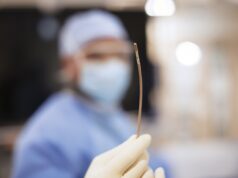
Mitralign has reported on the successful use of its technology to perform a percutaneous repair on a patient with tricuspid regurgitation. The company also announced that Joachim Schofer (Medicare Center and Department for Percutaneous Interventions of Structural Heart Disease, Albertinen Heart Center, Hamburg, Germany) and Rebecca Hahn (director of Interventional Echocardiography, Columbia University Medical Center/New York Medical Center/New York Presbyterian Hospital, USA) presented details of the procedure at PCR London Valves (28–30 September, London, UK).
The German regulatory body BfArM allowed the first-in-man procedure, which involves the percutaneous bicuspidisation of the tricuspid valve, to be performed under a compassionate use exemption because no other options were available for the patient who underwent the new procedure. According to a company press release, the procedure successfully converted a regurgitating tri-leaflet valve into a functioning bi-leaflet valve and was performed at the Albertinen Heart Center in Hamburg, Germany. The Mitralign product is currently being evaluated in clinical trials for an indication in functional mitral regurgitation. The device is not approved for sale or distribution.
“We continue to see more and more patients presenting with tricuspid regurgitation and to date, we have not had an interventional device available to treat these patients,” commented Schofer. “This is perhaps the most important intervention I have ever performed. It is the very first percutaneous tricuspid annuloplasty and it was performed successfully; dramatically reducing tricuspid regurgitation with a single small implant and improving the outcome for a patient who would have had a 30% chance of mortality with surgery. I expect that in the future, this will become an outpatient procedure as we start to treat more and more patients in this manner.”
Hahn said: “Current 2D and 3D echo imaging technologies allow us to easily and accurately place the implant in the correct location, and then immediately see dimensional changes in the valve once the procedure is completed.”













